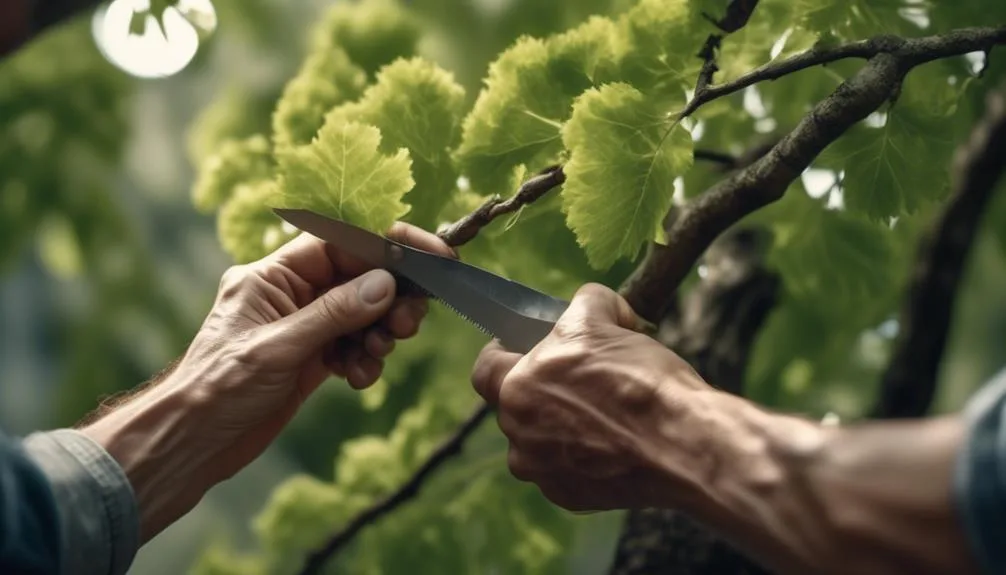Wondering if you can grow elm trees from cuttings?
Elm trees are stunning and adding them to your garden can be a great idea. While propagating elm trees from cuttings can be challenging, it's totally doable with the right knowledge.
Selecting the right cuttings and taking care of them as they root are crucial. Want to know how to do it? Stay tuned to learn the key steps for successfully propagating these iconic trees.
Elm Tree Propagation Basics
To propagate elm trees successfully, you'll need to understand the basics of elm tree propagation, including the best methods for taking and preparing cuttings. When taking cuttings for propagation, it's essential to use sharp, clean tools to prevent damage to the tree.
After taking the cuttings, applying rooting hormone to the cut ends can significantly improve the chances of successful root development. This hormone encourages the growth of new roots, increasing the cutting's ability to establish itself as a new tree.
Additionally, watering frequency is crucial during the propagation process. It's important to keep the soil consistently moist, but not waterlogged, to support root development.
Selecting and Preparing Elm Cuttings
When selecting elm cuttings for propagation, choose healthy, disease-free branches with a diameter of about 1/4 to 1/2 inch. Look for branches that are firm with no signs of damage or disease.
To prepare the elm cuttings for planting, follow these steps:
- Prune Wisely: Use sharp, clean pruning shears to take cuttings from the ends of healthy branches. Make clean cuts at a 45-degree angle to encourage root growth.
- Selecting Growing Medium: Choose a well-draining, nutrient-rich soil mix for planting the cuttings. A mix of peat moss, perlite, and coarse sand can be ideal for rooting elm cuttings.
- Preparing the Soil: Ensure the soil is moist but not waterlogged before planting the cuttings. This will provide the right environment for the cuttings to establish roots.
- Proper Planting Depth: Plant the elm cuttings about 2-3 inches deep in the prepared soil, ensuring that at least two nodes are below the soil line for successful root formation.
Propagating Elm Trees From Cuttings
You can propagate elm trees from cuttings by following a few simple steps that encourage successful root growth and establishment.
After preparing your elm cuttings, dip the cut end into a rooting hormone to promote root development. This hormone application is crucial for encouraging the cutting to establish roots in a new location.
Once the cuttings are treated with rooting hormone, plant them in a well-draining potting mix and water thoroughly. It's essential to maintain consistent moisture levels by watering the cuttings regularly, keeping the soil moist but not waterlogged. However, be cautious not to overwater, as this can lead to rotting.
With proper care and attention to watering frequency, your elm cuttings have a higher chance of successfully establishing roots and growing into healthy trees.
Caring for Elm Tree Cuttings
After planting your elm tree cuttings, ensure they receive adequate sunlight and protect them from extreme temperatures to promote healthy growth. Here are some caring tips to help your elm tree cuttings thrive:
- Regular Watering: Keep the soil consistently moist, but not waterlogged, to support root development.
- Protection from Harsh Conditions: Shield the cuttings from strong winds and frost to prevent stress and damage.
- Rooting Hormone Application: Use a rooting hormone to encourage the development of strong, healthy roots.
- Monitoring Growth: Regularly inspect the cuttings for signs of new growth and adjust care as needed.
Troubleshooting Elm Tree Propagation
If your elm tree cuttings are showing signs of stunted growth or yellowing leaves, troubleshooting the propagation process is essential to identify and address any issues affecting their development.
One common mistake is using unhealthy or diseased parent trees for cuttings, which can lead to failed propagation. Ensure that you select healthy, disease-free branches for the best chance of success.
Another issue could be overwatering or underwatering the cuttings. It's important to maintain consistent moisture levels without waterlogging the soil.
Additionally, using the wrong type of soil or rooting hormone can hinder the propagation process. Check that you're using a well-draining, sterile rooting medium and a suitable rooting hormone.
Conclusion
Incorporating the right techniques and care, propagating elm trees from cuttings is achievable. By selecting healthy cuttings, providing optimal growing conditions, and closely monitoring their progress, you can soon witness the growth of a beautiful new elm tree in your garden.
Happy propagating!

My interest in trees started when I first saw the giant sequoias in Yosemite.
I was a teenager then, and I remember thinking, “I need to learn more about this.”
That moment stuck with me.
A few years later, I went on to study forestry at Michigan Tech.
Since graduating, I’ve worked in a mix of hands-on tree care and community education.
I’ve spent over ten years helping people understand how to plant, maintain, and protect the trees in their neighborhoods.
I don’t see trees as just part of the landscape.
They are living things that make a real difference in our daily lives.
